Saturday, April 30, 2005
Æ ancient counterfeit antoninianus, Gallienus, Rome, as Göbl 579a
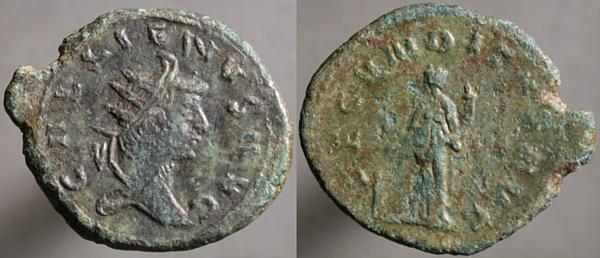
GALLIENVS AVG, Radiate head right | FECVNDITAS AVG, Fecunditas standing facing, head left, holding cornucopia right, reaching down to child, left.
Göbl notes (and plates) a mint-product example of this, a mule of Gallienus obverse with a reverse honoring Salonina's fecundity. This coin, though, is a bit wrong in so many ways: the lettering is clumsy in a different way than that of the mint, the emperor's face is not like those on official coins, and there's a great honking huge sprue at 9 O'Clock obverse / 3 O'Clock reverse.
I presume that it's so little worn because it didn't fool people who were used to spending the real thing.
Friday, April 29, 2005
Æ tetradrachm, Alexandria, Salonina, Emmett 3856(14)

KOPNHΛIA CAΛωNEINA CEB, Diademed draped bust right | LIΔ, Elpis standing left, holding flower left, hitching skirt right. Palm in left field, regnal year in right: IΔ within L.
In hunting what to post, I was surprised to find that I've only once before posted a coin showing Elpis, in that case another Alexandrian tetradrachm of Salonina, minted two years before this.
Elpis was adopted by the Romans as Spes, in either case portrayed as an adolescent girl, carrying a flower and holding her dress up off the ground. I've seen suggestions that this may represent a dance or other ritual performed in Spring. Not this one, which was supposed to be prehistoric, not merely ancient.
Thursday, April 28, 2005
Silvered AE antoninianus, Gallienus, Cyzikus, Göbl 1536Acvar...
Göbl (Sol holding whip right)
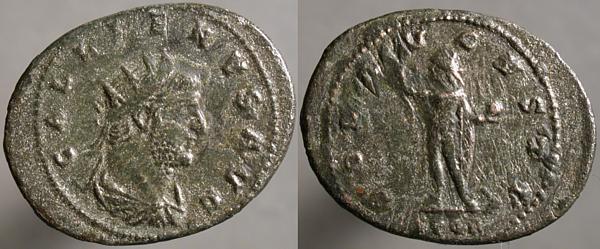
GALLIENVS AVG, Radiate draped cuirassed bust right, no pellets beneath | SOL AVGVSTI, Sol standing left, raising hand left and holding globe right. SPQR in exergue.
Göbl lists this reverse legend only for Sol holding whip, rather than globe. He attests only a single example of that, with radiate draped bust left with one pellet beneath. RIC does not list this reverse legend.
It's not as remarkable to find an apparently undocumented coin of Gallienus as it would be to find one in the name of, say, one of the Julio-Claudians, whose coins have been more closely studied and realize prices commensurate with the much greater interest.
And, to tell the truth, these are ugly little things made of poor quality metal. Interesting time in the empire though, and collecting these coins offers the standard small-pond benefits.

GALLIENVS AVG, Radiate draped cuirassed bust right, no pellets beneath | SOL AVGVSTI, Sol standing left, raising hand left and holding globe right. SPQR in exergue.
Göbl lists this reverse legend only for Sol holding whip, rather than globe. He attests only a single example of that, with radiate draped bust left with one pellet beneath. RIC does not list this reverse legend.
It's not as remarkable to find an apparently undocumented coin of Gallienus as it would be to find one in the name of, say, one of the Julio-Claudians, whose coins have been more closely studied and realize prices commensurate with the much greater interest.
And, to tell the truth, these are ugly little things made of poor quality metal. Interesting time in the empire though, and collecting these coins offers the standard small-pond benefits.
Wednesday, April 27, 2005
Æ20, Nicaea in Bythinia, Gordian III, Sear Greek Imperial 3671
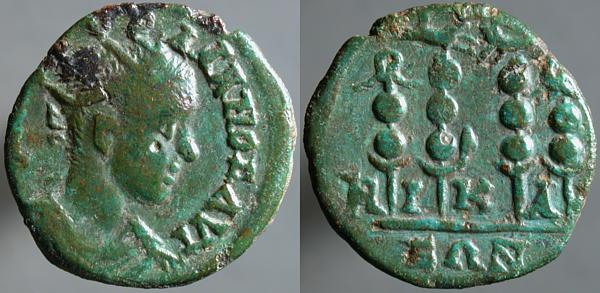
[M ANT ΓO]PΔIANOC AVT, Radiate draped bust right | N_I_K_A_[I] / EΩN, Four standards, eagles atop the middle two.
Marcus Antonius Gordianus Pius, grandson of Gordian I was made Caesar, heir to the empire, by the Senate during the brief reign of Balbinus and Pupienus, and he acceeded to Augustus after their deaths in 238, when he was thirteen. Timesitheus, praetorian prefect, acted as power behind the throne and undeclared regent and arranged the marriage of his daughter Tranquillina in 241. In 243, in the midst of a punative campaign against the Persian king Shapur I (who continued to trouble the Romans for the rest of his life,) Timesitheus sickened and died. His replacement as praetorian prefect, Marcus Julius Philippus, within a year oversaw the death of Gordian and his own acclamation as Emperor.
This is one of the commonest coins of the Roman provinces, and is seen with many variations of the standards on the reverse and the placement of the letters among them.
Tuesday, April 26, 2005
Æ27, Samos (Ionian Island), Gallienus, SNG von Aulock 3775
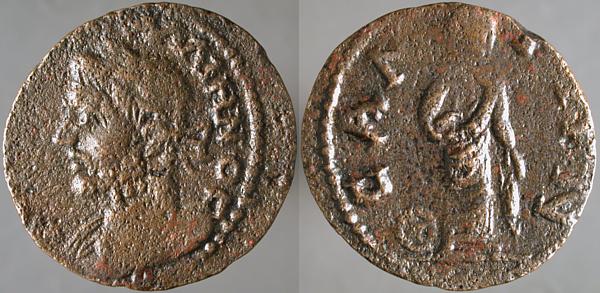
AYT K ΠO ΛIK ΓAΛΛIHNOC, Laureate draped cuirassed bust left | CAM_IΩN, Nemesis, wearing long chiton and himation, standing facing, wheel at feet left.
Nemesis, the Greek goddess of just retribution, has no precise Roman equivalent. Ivstitia is a more general Roman goddess of justice, and in modern times is portrayed carrying the scales of Aeqvitas.
This coin, posted earlier shows a winged Nemesis, today's coin shows her without. Both, though, show her wheel, apparently equivalent to Tyche's rudder but visually different, to aid in identification.
Monday, April 25, 2005
Billon antoninianus, Gallienus, Köln, Göbl 874m
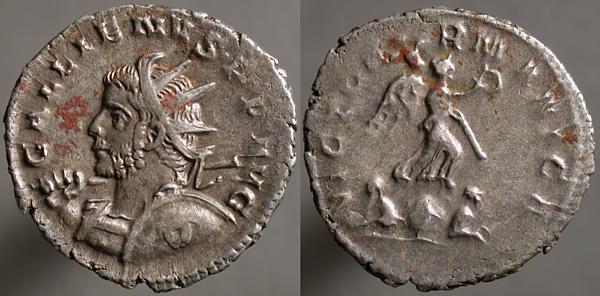
GALLIENVS P F AVG, Radiate cuirassed bust left with decorated shield on near shoulder and spear on far | VICT GERMANICA, Victory walking right on globe, trophy over shoulder, holding wreath right, two captives below.
Globes on ancient coins are often interpreted as representing the Earth, which ignores the use of the celestial globe in "natural philosophy." The metaphor here, though, doesn't depend on which of those globes is seen: Roman Victory astride the Earth, or the universe, her enemies fettered beneath her feet.
Sunday, April 24, 2005
Æ23, Cotiaeum in Phrygia, quasi-autonomous, SNG von Aulock 3775
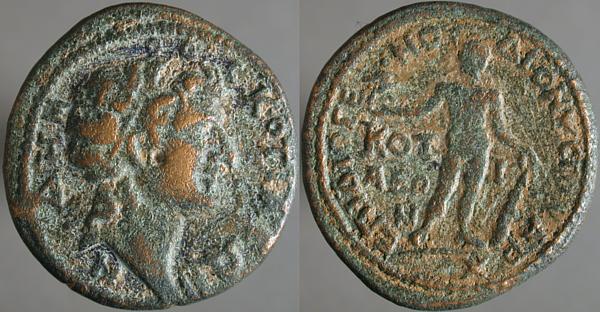
ΔHM_OC KOTIAEΩ_N, Diademed head of Demos right | EΠI ΔIOΓE_NOY ΔIONYCIOY APX, Herakles standing facing, holding club right and Kybele left. KOT / I / AEΩ / N scattered around fields.
What would you expect your city's magistrate to be named if not Diogenes Dionysys? It's fate, there's no avoiding it. He probably wasn't any happier about it than we are. We've seen his name before, as it happens.

